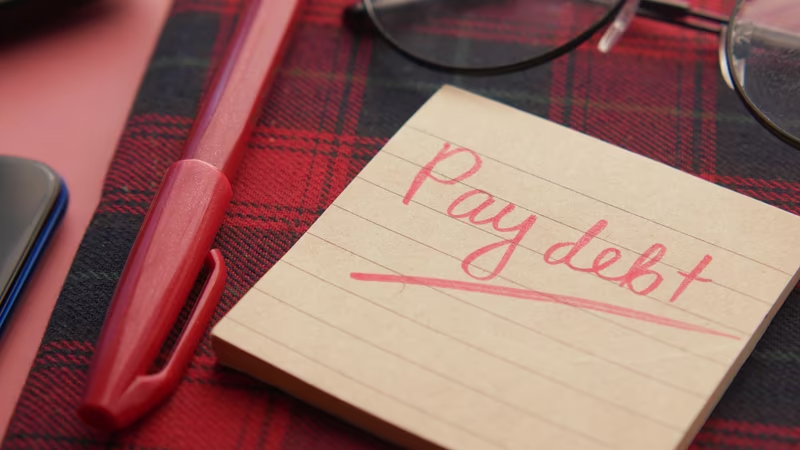There are several tales of how millionaires, billionaires, and corporations have lost everything because of excessive debt. Hence, when you are managing your finances as a young adult, it is important to know how you should avoid debt in your 20s
It is not unknown that debt is one of the primary causes of depression, breakups, divorces, and high-stress levels. However, despite its prevalence, people often underestimate debt.
It's not good for your financial health. Hence, understanding how much debt is too much is crucial.
In this article, we have prepared a comprehensive guide that explains the acceptable amount of debt a person can have, signs that you may have too much debt, and a few tricks to get rid of them. Interested?
Keep reading.
How much debt is too much?
Many people today live on an endless pile of debt. Most commonly, it is credit card debt.
If not managed carefully and monitored closely, this can lead to a debt trap, which can be extremely challenging to break.
Hence, it is crucial to keep your debt as low as possible. If you are worried that you may have a high debt load, then look at your Debt-To-Income (DTI) ratio.
Money lenders use the DTI ratio to see how much of your gross monthly income is utilized to pay your debts each month and assess your risk of borrowing.
In simple words, divide the total of your monthly debt payments (including credit card bills, mortgage payments, and auto loans) by your gross monthly income.
If your debt loads are more than 36% of your monthly income, paying off the borrowed money might be challenging, making getting credit more difficult.
Let's take an example:
Rohit's monthly take-home salary is ₹36,000.
His monthly credit card bill is ₹5,000
He has an EMI for a car loan, which is ₹3,750
Rohit also pays toward an advance salary loan, which costs him ₹15,000
Rohit’s total monthly debt load is ₹5,000 + ₹3,750 + ₹15,000 = ₹23750
Hence, his DTI is ₹23750/₹36,000 = 0.65% or 65%. We can easily see Rohit's DTI is extremely high.
The 28/36 Rule
A general thumb rule to follow for managing debt load is to follow the 28/36 rule. According to this rule, a person should not use more than 36% of their take-home salary toward paying the debt. Ideally, you should spend only 28% on household expenses.
Hence, if Rohit's monthly take-home salary is ₹36,000, he should not spend ₹12,900 toward debt repayment and ₹10,080 on his household expenses. The rest of ₹13,020 Rohit should invest and spend on his wants.
Common signs that you may have too much debt
According to studies, debt is a significant cause of depression, anxiety, stress, or suicide ideation in Asian countries.
Furthermore, 60-70% younger individuals aged 20-30 years living in a household with debt than those aged 60-64 years (39%) and 80-84 years (11%).
You have too much debt if you're having trouble making your payments or if they're so high that you can't do much else.
Other than that, the common signs of having too much debt include:
- You are unaware of your debt amount.
- You frequently pay bills late because you never have enough money to spare.
- You avoid bill collectors' calls.
- You often make little purchases using credit cards.
- You lack emergency savings and are unable to start one.
- You take out loans to cover your debts.
- You can't sleep peacefully because of your financial woes.
- More than half of your income is consumed by your overall debt.
- Your family is unaware of the money you spend.
6 Tricks on how to avoid surplus debt in your early 20s
1. See where your money is leaking
When you spend more than you can comfortably afford, you fall into a debt trap. The first step to getting out of the debt trap is to evaluate your current situation. Examine your bank and credit card statements carefully.
Do you have multiple EMIs on your credit card? Do you purchase an expensive item every month? Remember, you can only save when you know which purchase is necessary and which is a want.
2. Payoff bad debts first
Make a debt repayment strategy to tackle your debt trap. Get help from a financial advisor if you need assistance building a plan that works for you.
The snowball method is the easiest and most commonly used method to tackle debt. According to this, pay off the smallest loan before paying the bigger loan debts.
Until the smaller debts are paid off, spend a little more than the minimum due amount for the bigger loans to avoid paying high-interest fees.
3. Be careful of how you use your credit cards
Due to larger credit card limits and the alluring cashback and incentive programs offered by credit cards, the younger generation has a propensity to spend more.
Simply sliding a credit card instead of carrying cash around is much simpler. However, that is the cause of all debt traps. Only use a credit card if it is required.
Also, pay your entire amount due every month. Do not hold onto any unpaid balances. If not, you would be required to pay high interest.
If you do not pay your monthly bill payments on time regularly, it is so simple to fall into a pit of credit card debt.
4. Prioritize building an emergency fund
The emergency fund is the safety net you can use when things don't go according to plan.
Whether you experience a medical emergency, a job loss, or an unexpected cost to pay, having an emergency fund will stop you from applying for a short-term loan with a high-interest rate.
Your emergency fund should typically be enough to pay for six to nine months' worth of living expenditures. Set aside some money each month in a surplus cash contingency account to easily create an emergency fund.
5. Hustle & earn additional income
If you are good at something, monetize it. Find ways to maximize your revenue in addition to controlling your expenses.
Start a content writing business, for instance, if you are confident in your writing abilities and vocabulary, or look at prospects for product or wedding photography if you enjoy photography.
Your side hustle can be anything. Take some time from your primary job, and start a freelance or part-time job.
This additional inflow of money will help you pay off your debts faster or spend on things you love.
6. Avoid lifestyle inflation
As social media continues to influence our lives, many people, especially Gen X, often feel inferior if their home doesn't look a specific way or if they don't drive a certain kind of vehicle like their peers. Thus, they are propelled into spending beyond their means. It is called lifestyle inflation.
But you can prevent this lifestyle creep by understanding the distinction between wants and needs. For instance, while pampering yourself occasionally is fine, choosing an unsustainable lifestyle is not ideal if you cannot afford it.
Conclusion
It can be beneficial if you utilize debt wisely and can afford it with your salary and savings. Next time you click the Buy Now button on your shopping app or go shopping for something extravagant, take a mental step back and analyze 'do you really need it?' You'll have your answer.
Remember, you'd need a lot of patience to stop the debt trap. If you think a repayment strategy is worth a try, stick to it. Keep in mind that those unpaid balances were amassed over time—possibly years. Similarly, recovery also will take time and patience.










